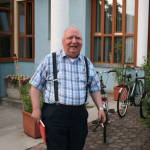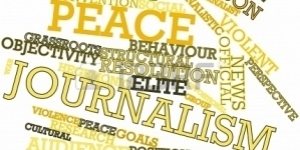What Is Peace Journalism?
TMS PEACE JOURNALISM, 24 Oct 2016
Antonio C. S. Rosa | Editor – TRANSCEND Media Service
A) by Prof. Jake Lynch
 Peace journalism is when editors and reporters make choices – about what to report, and how to report it – that create opportunities for society at large to consider and to value non-violent responses to conflict.
Peace journalism is when editors and reporters make choices – about what to report, and how to report it – that create opportunities for society at large to consider and to value non-violent responses to conflict.
If readers and audiences are furnished with such opportunities, but still decide they prefer war to peace, there is nothing more journalism can do about it, while remaining journalism. On the other hand, there is no matching commitment to ensuring a fair hearing for violent responses, if only because they seldom struggle for a place on the news agenda.
How come? To report is to choose. ‘We just report the facts’, journalists say, but ‘the facts’ is a category of practically infinite size. Even in these days of media profusion, that category has to be shrunk to fit into the news. The journalist is a ‘gatekeeper’, allowing some aspects of reality through, to emerge, blinking, into the public eye; and keeping the rest in the dark.
Neither is this a random process. The bits left out are always, or usually, the same bits, or the same sorts of bits. News generally prefers official sources to anyone from the ‘grassroots’; event to process; and a two-sided battle for supremacy as the basic conflict model.
These preferences, or biases, hardened into industry conventions as journalism began to be sold as a mass-produced commodity in consumer societies, and faced pressure to present itself as all-things-to-all-people, capable of being marketed to potential readers, listeners and viewers of all political views and none.
Quoting officials – a category topped by the political leader of one’s own country – is a choice and a preference, but one with a built-in alibi. It was not our ‘fault’ that this person became head of government: s/he just ‘is’. ‘Indexing’, or the familiar journalistic habit of restricting the extent of debate to differences between government and official opposition – ‘elite discord’ – has the same effect, of camouflaging choices as facts.
What about event and process? News that dwells on, say, the details of death and destruction wrought by a bomb, avoids controversy. The device has, indisputably, gone off. There are well-attested casualty figures, from trustworthy sources such as hospitals and the police. What is automatically more controversial is to probe why the bombers did it, what was the process leading up to it, what were their grievances and motivations.
As to dualism, well, when I was a reporter at the BBC, we all realised that a successful career could be based on the following formula: ‘on the one hand… on the other hand… in the end, only time will tell’. To have ‘balance’, to ‘hear both sides’, is a reliable way to insulate oneself against complaints of one-sidedness, or bias.
War Journalism and Its Antidote
There are deep-seated reasons, then, why these are the dominant conventions in journalism, but, taken together, they mean that its framing of public debates over conflict issues is generally on the side of violent responses. It merits the description, ‘war journalism’.
How come? Take the dualism first. If you start to think about a conflict as a tug-of-war between two great adversaries, then any change in their relationship – any movement – can only take place along a single axis. Just as, in tug-of-war, one side gaining a metre means the other side losing a metre, so any new development, in a conflict thus conceived, immediately begs to be assessed in a zero-sum game. Anything that is not, unequivocally, winning, risks being reported as losing. It brings a readymade incentive to step up efforts for victory, or escalate. People involved in conflict ‘talk tough’ – and often ‘act tough’ – as they play to a gallery the media have created.
Remove acts of political violence from context and you leave only further violence as a possible response. This is why there is so little news about peace initiatives – if no underlying causes are visible, there is nothing to ‘fix’. Only in this form of reporting does it make any sense to view ‘terrorism’, for example, as something on which it is possible or sensible to wage ‘war’.
And if you wait, to report on either underlying causes or peace initiatives, until it suits political leaders to discuss or engage with them, you might wait a long time. Stirrings of peace almost invariably begin at lower levels. There is, furthermore, a lever in the hands of governments that no one else has – the ‘legitimate’ use of military force. For all these reasons, the primacy of official sources, coupled with the enduring national orientation of most media, is bound to skew the representation of conflicts in favour of a pronounced receptiveness to the advocacy of violence.
Hence, peace journalism, as a remedial strategy and an attempt to supplement the news conventions to give peace a chance.
Peace Journalism:
- Explores the backgrounds and contexts of conflict formation, presenting causes and options on every side (not just ‘both sides’);
- Gives voice to the views of all rival parties, from all levels;
- Offers creative ideas for conflict resolution, development, peacemaking and peacekeeping;
- Exposes lies, cover-up attempts and culprits on all sides, and reveals excesses committed by, and suffering inflicted on, peoples of all parties;
- Pays attention to peace stories and post-war developments.
Reality and Representation
Peace journalism is more realistic, in the sense of fidelity to a reality that already exists, independently of our knowledge or representation of it. To report violence without background or context is to misrepresent it, since any conflict is, at root, a relationship, of parties setting and pursuing incompatible goals. To omit any discussion of them is a distortion.
At the same time, it acknowledges that there is no one correct version of this reality that everyone will agree upon. We understand the world around us by taking messages and images – including those served up by the news – and slotting them into codes we develop through our lives and carry in our heads. Meaning is not created solely at the point of production, or encoding; no act of representation is complete until it has been received, or decoded. Decoding is something we often do automatically, since so much of what we read, hear and see is familiar. This is what propaganda relies on – establish Saddam Hussein as a ‘bad man’, or ‘weapons of mass destruction’ as a ‘threat’, and it forms a prism, through which all the reality, both subsequent and previous, tends to be viewed.
Journalism is often easy prey for such efforts because it does not generally encourage us to reflect on the choices it is making, for reasons discussed above. The famous US ‘anchor-man’, Walter Cronkite, signed off CBS Evening News every night with the catchphrase, “that’s the way it is”. How it came to be that way would be an interesting conversation, but it is not one in which news is generally keen to engage.
Communications students will recognise the last few paragraphs as a potted version of reception theory. In writing this introduction, I’ve resisted academic sources, because, yes folks, the clichés are true, media scholars often do dress in black (which we won’t hold against them) and chew polysyllables for breakfast (which we might). However it’s worth quoting one famous aphorism coined by a clever and original researcher, Gaye Tuchman: “the acceptance of representational conventions as facticity makes reality vulnerable to manipulation”.
So peace journalism is in favour of truth, as any must be. Of course reporters should report, as truthfully as they can, the facts they encounter; only ask, as well, how they have come to meet these particular facts, and how the facts have come to meet them. If it’s always the same facts, or the same sorts of facts, adopt a policy of seeking out important stories, and important bits of stories, which would otherwise slip out of the news, and devise ways to put them back in. And try to let the rest of us in on the process. Peace journalism is that which abounds in cues and clues to prompt and equip us to ‘negotiate’ our own readings, to open up multiple meanings, to inspect propaganda and other self-serving representations on the outside.
Can journalists actually do this, and do they? Latterly, researchers have set out to gauge the amount of peace journalism that is going on. There is probably no one piece of reporting that exhibits all five of the characteristics listed above, whilst also avoiding demonizing language, labeling and so forth. But distinctions do exist, and they have been measured. Reporting in The Philippines, especially by the country’s main newspaper, the Philippine Daily Inquirer, is interesting in providing an effective counter to attempts by the country’s government to import the ‘war on terrorism’ ideology and apply it to a long-running insurgency. The paper I used to work for, the Independent of London, does a lot of peace journalism.
Then of course there are proliferating independent media, now building, through web-based platforms, on traditions long nurtured by alternative newspapers and community radio stations. There is some peace journalism, so there could be more.
********************************
Jake Lynch is Associate Professor and Director of the Centre for Peace and Conflict Studies at the University of Sydney. Before that, he spent nearly twenty years in journalism, including spells as a newsreader and presenter for BBC World television, a Political Correspondent for Sky News and the Sydney Correspondent for the Independent newspaper. He reported on conflicts in the Middle East, South East Asia and South East Europe, as well as countless political and diplomatic meetings and developments in the UK and Europe.
He is the co-author, with Annabel McGoldrick, of Peace Journalism (Hawthorn Press, 2005), and his new book, Debates in Peace Journalism, has just been published by Sydney University Press and TUP – TRANSCEND University Press.
He also co-authored with Johan Galtung and Annabel McGoldrick ‘Reporting Conflict-An Introduction to Peace Journalism.’
In Spanish, ‘Reporteando Conflictos-Una Introducción al Periodismo de Paz‘ (Ariete, TRANSCEND México, Respuestas para la Paz, 2006). Translated by Fernando Montiel T.
In Portuguese, ‘Cobertura de Conflitos-Uma Introdução ao Jornalismo para a Paz’ (TRANSCEND University Press México, 2010). Translated by Antonio Carlos Silva Rosa.
—————————————————————————————————————————–
B) by Prof. Dietrich Fischer
 Johan Galtung is often asked to define peace journalism. In the most concise way, he says, it is to ask two questions (in addition to the usual questions like how many bombs were dropped, how many buildings destroyed, who is winning, etc.):
Johan Galtung is often asked to define peace journalism. In the most concise way, he says, it is to ask two questions (in addition to the usual questions like how many bombs were dropped, how many buildings destroyed, who is winning, etc.):
“What is the conflict about, and what could be the solutions?”
If George W. Bush were asked, “What is the conflict with Iraq about?”, he would probably reply, “It is a struggle between good and evil.” “Would you like to expand on that?” “No.” “What is the solution?” “To crush evil!” “Would you like to expand on that?” “No.” If he were asked this twenty times, and quoted each time, he could not get away with it forever. Bush is being under-quoted.
In the 18th century, we had “disease journalists” who reported in detail how epidemics were spreading and how people suffered, but little was known about cures and little reported. Today we have “health journalists” who write about current research on new cures for diseases, and healthy lifestyles that help prevent disease.
The time has come for “peace journalists” to write not only about war, but also about its causes, prevention, and ways to restore peace. They need not invent solutions to conflicts themselves–in the same way as health journalists need not invent cures for diseases themselves; they ask specialists.
Similarly, peace journalists can ask various peace organizations and mediators about their ideas for preventing or ending a violent conflict, and report about it. Health pages in newspapers are very popular, and it can be anticipated that the same will be true for reporting about peace proposals, once they become available.
People thirst for peace. All we ask is “Give peace a page.”
********************************
Dietrich Fischer (1941-2015) from Münsingen, Switzerland, got a Licentiate in Mathematics from the University of Bern 1968 and his Ph.D. in Computer Science from New York University 1976. 1986-88 he was a MacArthur Fellow in International Peace and Security at Princeton University. He has taught mathematics, computer science, economics and peace studies at various universities and been a consultant to the United Nations.
________________________________________________
Antonio Carlos Silva Rosa, born 1946, is the editor of the pioneering Peace Journalism website, TRANSCEND Media Service-TMS, an assistant to Prof. Johan Galtung, and Secretary of the International Board of the TRANSCEND Network for Peace, Development and Environment. He completed the required coursework for a Ph.D. in Political Science-Peace Studies (1994), has a Masters in Political Science-International Relations (1990), and a B.A. in Communication (1988) from the University of Hawai’i. Originally from Brazil, he lives presently in Porto, Portugal. Antonio was educated in the USA where he lived for 20 years; in Europe/India since 1994.
Tags: Conflict, Nonviolence, Peace Journalism, Truth
This article originally appeared on Transcend Media Service (TMS) on 24 Oct 2016.
Anticopyright: Editorials and articles originated on TMS may be freely reprinted, disseminated, translated and used as background material, provided an acknowledgement and link to the source, TMS: What Is Peace Journalism?, is included. Thank you.
If you enjoyed this article, please donate to TMS to join the growing list of TMS Supporters.

This work is licensed under a CC BY-NC 4.0 License.
Read more
Click here to go to the current weekly digest or pick another article:
TMS PEACE JOURNALISM:
